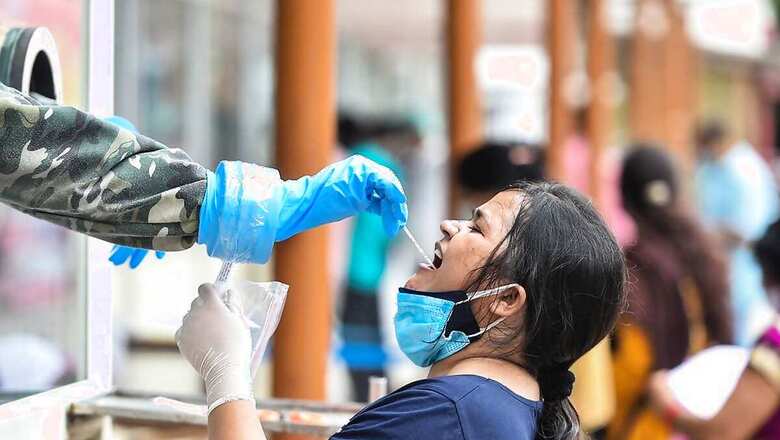
views
On 10 May 2021, India reported more new cases than all other countries combined. Yet the question remains, is India testing enough? The answer may not be straightforward. This is because on the one hand, there are testing infrastructure barriers such as shortage of testing kits and testing staff and availability of testing centres, especially in rural areas. On the other hand, there are bureaucratic barriers where health authorities are seen dissuading individuals from taking the tests.
Hypothetically, if these barriers to testing were removed, and that health authorities were actively encouraging individuals to come forward to test for free at fully resourced testing centres at accessible locations, would individuals then come out to test in queues? It cannot be ruled out that many would indeed queue up to take the COVID-19-test; however, anecdotally at least, in India, testing hesitancy is observed across the Indian landscape cutting across all sections of the Indian society. Rural India, affluent Indians, and Indians from the North of India are all as hesitant to test as their counterparts—urban India, non-affluent Indians, and Indians in the south, east, and west of India.
Factors Contributing to Vaccine Hesitancy
COVID-19 test hesitancy appears to have roots in the psychological distress associated with contracting the novel coronavirus. Distress triggers reinforce negative emotions of fear and anxiety, aloneness, anger, sadness, shame, and embarrassment. These negative emotions manifest themselves as an ongoing lived experience of trauma—individual or collective, psychological or embodiment. And this has the potential to trickle down from generation to generation, i.e., intergenerational trauma, directly or indirectly.
It is imperative to note that what is being transmitted is not just the trauma itself, but also the consequences of having been traumatised. Direct transmission can be thought of as where the subconscious of the offspring internalises traumatic information, translating it into a natural progression of living and conducting life. In other words, offsprings behave as if they themselves have been there. Indirect transmission can be thought of as where the unconscious assimilation of traumatic information manifests itself into a modified subconscious way of living and conducting life, thus, affecting the offspring of the offsprings.
In India, the ongoing lived traumatic COVID-19-related experience is influenced and exacerbated by pre-existing systemic social inequities, a source of (intergenerational) trauma in itself. This has the potential of resulting in a new re(experience) of trauma. Given the complexity with which human emotions traverse societal planes across generations over time, Indians appear to be hesitant to test for COVID-19 even when they show symptoms.
Conditions of COVID Centres
For example, home isolation in India is not always possible, because many households continue to live as joint families sharing tight spaces. As a result, many have to look outside their homes for COVID-19 care. But isolating at designated COVID-19 care centres has not been desirable.
Many did not want themselves or their loved ones to live through the experience of what they had seen and heard about COVID-19 care centres in both the mass and contemporary media. Experience of (a) living in unhygienic conditions; (b) sharing beds with other COVID-19 patients, sleeping on the floor, and sometimes even being asked to share beds with the dead; (c) squeezing into overcrowded make-shift centres lacking basic facilities such as electricity, toilets, beds, doors, windows for ventilation, and (quality) food.
Despite upgraded treatment facilities, there is hesitancy to move to COVID care centres. This is because there is a widespread belief that admissions to COVID-19 care centres could essentially mean death. Moreover, with the bodies of the departed not being returned, incomprehensible unresolved grief along with lack of information and transparency has given rise to a narration that hospital visitors are coerced into being tested for COVID-19, then isolated despite pending results, and then turning up dead soon after. The narration has added fuel to the credence that COVID care centres are hubs for illicit activities—a place where individuals are being injected with the coronavirus itself, and human organs are illegally being harvested.
In fact, individuals either believe or are guided to believe that their symptoms could be that of seasonal flu or typhoid or any other virus emanating from an ominous presence. Many continue to believe that the virus is a conspiracy, to divert attention from the government’s failure. Their belief is finding further support in (1) claims suggesting that COVID-19 diagnostic testing could misdiagnose a common cold or flu as coronavirus; and (2) potential false negatives from both RT-PCR and rapid antigen tests (RAT), and (3) deaths despite testing negative for COVID-19.
The Rise of the Infodemic
And then there is the infodemic, which in India also appears to be promoted by government agencies. Additionally, lack of a regularly updated comprehensive systematic COVID-19 treatment guidelines, and in the face of death, the compulsion “to do something” and “what is the harm” belief, has made COVID-19 treatments result in either antibiotic resistance or fatal consequences. Families are pressuring doctors to prescribe medications or concoctions, and doctors also appear to be resorting to a cocktail of medicines, sometimes turning to what they have on hand. Individuals appear to be self-medicating by either resorting to peer advice or borrowed prescriptions or referring to unverified prescriptions available on social media.
Social Stigma
There is also the social stigma associated with COVID-19, leading to social ostracisation and discrimination. Besides, policies perceived as discriminatory have bred a great deal of distrust. For example, the Maharashtra government issued an order advising co-operative housing societies (CHs) to ensure that all persons coming into the building on a regular basis get tested until they are vaccinated. Accordingly, CHs used the order to mandate service providers—domestic help, drivers, society staff, etc.—to carry a recent negative test report.
Shifting the onus of testing only on service providers seeded distrust between both the residents and service providers. The distrust is exacerbated by lack of clarity on who pays for the test, and concerns about job security. Moreover, testing positive could mean that their work would be neglected and that they may not be compensated for their time while in quarantine, or that they would not be able to find work post-quarantine. Consequently, many service providers chose to forgo their jobs rather than get tested, and some residents even chose to create fake test reports.
Conclusion
Recognising the complex interactions between ongoing lived experience of COVID-19-related trauma, and traumatic experience associated with systemic social inequities, can help identify the reasons behind India’s prevalent testing hesitancy.
Accordingly, efforts can be directed towards proactively addressing the hesitancy quagmire. For example, lower caste village residents may be hesitant to test because given their socio-economic status; a positive on the test could mean reinforcement of already existing social discrimination. On the other hand, upper caste village residents may be hesitant to test because testing positive could mean sharing quarantine facilities with lower caste village residents. Therefore, localised COVID-19 management committees should include a cross-section of the society. Moreover, accountability mechanisms should be in place with whistle blower protection so that any wrongdoing of the management committees is addressed without fear of persecution.
If residents of a village are hesitant to test believing that it could just be a seasonal flu, then an awareness programme could help. However, an awareness programme can only be effective when appointed local officials, could also be local AAA (ASHAs, ANMs and Angadi workers), visit homes disseminating correct information without socio-economic bias, in their local dialect, mediated through local people of influence—local political or religious leaders, respected member/family (of a particular caste) in the village, local doctors or teachers or the sarpanch or members of self-help groups.
The benefits of addressing the vaccine hesitancy quagmire can spill over to inform policies whose objective is to curtail the spread of COVID-19 infections. For example, the Karnataka government decided that COVID-19 patients in urban slums and rural areas would have to be admitted to COVID-19 care centres. While it may be prudent to end home isolation, the policy is already seeing a backlash amongst patients who are demanding to continue with home isolation. Amidst reported testing hesitancy in rural Karnataka, ending home isolation may fuel the prevalent testing hesitancy.
Given India’s unique challenge, it is imperative to direct research efforts towards understanding the reasons behind India’s testing hesitancy. Surely, the reason why a person in Mumbai, Maharashtra is hesitant to test might be different for a person in Beed, Maharashtra or Bengaluru, Karnataka. The reason why a high-rise resident is hesitant to test might be different to the slum dwellers. The reason why a person from caste X in village A is hesitant to take the COVID-19 test might be different to a person from caste X in village B or a person from caste Y in village B, in the same state or outside.
A multi-pronged approach involving different stakeholders from the government to local officials and individuals is imperative to overcome the varied challenges that arise from testing hesitancy.
This article was first published on ORF.
Read all the Latest News, Breaking News and Coronavirus News here.



















Comments
0 comment